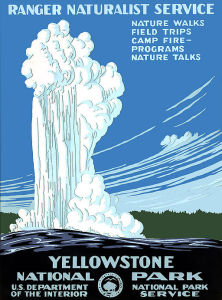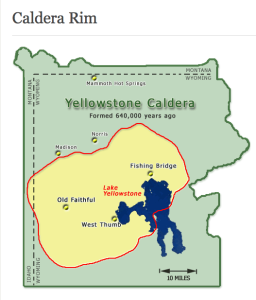

In my last post on the topic of Yellowstone, I discussed what gives it the heat, and mentioned it is known as a super caldera. Super does not refer to the size of the caldera detectable in the northwestern corner of Wyoming, an oval bowl about 34 by 45 miles well concealed by the acres and acres of evergreen trees in the national park. No, the super description refers to what it has proven it can do over the last 16.5 million years.
The United States Geological Survey requires a volcano to put out 1,000 cubic kilometers of ejecta (lava, ash, etc.) to earn the super caldera (or super volcano) tag. Some scientists go as low as 300 cubic kilometers. Give me something to compare this to, you say. Well, Mt. St. Helens maybe put out 1 cubic kilometer in 1980, the only comparison most North Americans can relate to. Three hundred times that is enough to kill and inconvenience many people. One thousand times that is a climate-altering shedload.
So let’s go all the way and use the 1,000 cubic kilometers standard. There are two Yellowstone eruptions in the last 2.1 million years believed to achieve the USGS’s “super” designation. The most recent was 630,000 years ago with an ejecta volume estimated to be right on the 1,000 cubic kilometers number. The biggest known was two million years ago that put out a whopping 2,500 cubic kilometers. OMG. There was another in between those two, 1.3 million years ago, at a volume of about 280.
Are all these numbers making your eyes glaze over? They probably should. It is almost impossible to conceive of eruptions of this size when what most of us visualize from a volcano are the placid, picturesque flows of Kilauea in Hawaii or the relatively localized devastation from Mt. St. Helens. Admittedly, most of Yellowstone’s volcanic activity is on a similarly small scale. There’ve been fifteen to twenty eruptions identified since the hot spot’s oldest known one, when it was percolating below what is now Nevada’s northern border. Possibly two of those were super. And there are probably many that were so small they have been lost to the geologic record.
![By Árni Friðriksson (Own work) [CC BY-SA 3.0 (http://creativecommons.org/licenses/by-sa/3.0) or GFDL (http://www.gnu.org/copyleft/fdl.html)], via Wikimedia Commons](http://www.jillhughey.com/wp-content/uploads/2015/01/Eyjafjallajokull-April-17-300x225.jpg)
Next time, I’ll discuss the fact that sizable volcanic eruptions are anything but localized events, and the blast of a super caldera anywhere on Earth would impact every living thing on our planet. I’ll give you a hint: having measurable ash fall on you is only part of the problem.



Sorry, comments are closed for this post.